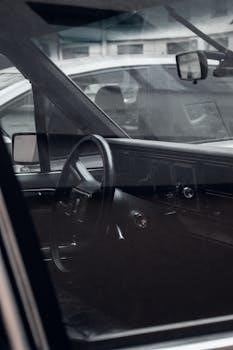Upgrading from manual to electric seats is a popular modification for enhanced comfort and convenience. Many kits offer a way to control your factory seat with power window-type switches, improving adjustability and ease of use. These conversions often increase legroom too.
Understanding the Need for Conversion
Many drivers find the limited adjustability of manual seats inconvenient, especially when sharing a vehicle with others. Manual seats often require awkward reaching and physical effort to reposition, which can be frustrating and unsafe. This can lead to discomfort on long drives or difficulty achieving an optimal driving position. The desire for a more luxurious and convenient experience motivates many car owners to consider upgrading to electric seats. Furthermore, those with physical limitations may find manual adjustments challenging, making power seats a necessary upgrade for accessibility. The ability to make precise adjustments with the touch of a button offers greater comfort and customization. For some, the conversion is about adding features found in higher-trim models, thus enhancing the overall driving experience and vehicle value. Ultimately, the need for a manual to electric seat conversion stems from a desire for enhanced comfort, convenience, and accessibility.
Benefits of Electric Seats
Electric seats offer numerous advantages over their manual counterparts, primarily focusing on convenience and comfort. The most significant benefit is the effortless adjustment, allowing drivers to find their ideal seating position with minimal effort. Precise adjustments, often in multiple directions, cater to individual preferences and body types. This is particularly beneficial for drivers who spend long hours on the road, reducing fatigue and increasing comfort. Electric seats also enhance safety by allowing drivers to maintain a proper driving posture with better visibility. The ability to save seat positions, often via memory settings, is another valuable feature, especially when multiple people use the same vehicle. This avoids the hassle of readjusting the seat each time. Furthermore, electric seats can add a touch of luxury and sophistication to a vehicle, aligning with modern expectations of convenience and technology. Overall, the benefits of electric seats translate to a more comfortable, safe, and enjoyable driving experience.

Components of a Power Seat Conversion Kit
Power seat conversion kits typically include new seat track mounting plates, seat frame mounting bolts, and track to floorboard mounting bolts. Some kits may also provide wiring harnesses and switches for control.
Essential Parts Included in Kits
A standard power seat conversion kit is designed to provide all the necessary components for a smooth upgrade. These kits usually feature custom power seat tracks that are engineered to bolt onto the existing factory seat frame and seat riser. This ensures a secure and compatible fit within the vehicle. Furthermore, you’ll find specialized mounting plates designed for the tracks, along with all the required bolts and hardware for attaching the seat frame to the floorboard. The kit also contains components that facilitate the electrical operation, including wiring harnesses and connectors which are often designed to interface with the existing vehicle wiring system. Some kits will also include a switch panel that allows the user to control the seat’s movement. It is important to note that while these kits are very comprehensive, they do not typically include the actual seats themselves, but rather focus on the components needed to motorize the existing ones.
Types of Conversion Kits Available
The market offers various types of power seat conversion kits, each catering to different needs and preferences. Some kits are designed for universal application, aiming for broad compatibility across various vehicle makes and models. These typically involve adjustable mounting points and can be adapted to fit multiple seat designs. Other kits are vehicle-specific, providing a more tailored fit for particular models or series. These kits often include more precise mounting brackets and wiring harnesses, simplifying installation. Furthermore, some conversion kits focus solely on basic power adjustments, such as forward/backward and up/down movement, while other advanced kits include additional features like power lumbar support, seat heating, or memory settings. The complexity of the kit often influences the installation process and the overall cost, allowing consumers to choose a kit that matches their vehicle and budget.

Installation Process
Installing a power seat conversion kit generally involves mechanical and electrical work. This includes mounting new seat tracks, connecting wiring, and ensuring proper functionality. Some kits utilize factory mounting points for easier installation.
Step-by-Step Guide to Installation
The installation process typically begins with the removal of the existing manual seat. This involves unbolting the seat from the floor and disconnecting any existing wiring harnesses. Next, the new power seat tracks are mounted to the vehicle’s floor using the provided hardware, often utilizing factory mounting points to ensure proper alignment. The seat frame is then attached to these new tracks. Wiring is a critical step, requiring connecting the power seat motor to the vehicle’s electrical system, and possibly integrating a power switch. This may involve tapping into existing power sources or running new wires. Once the electrical connections are complete, the seat is carefully lowered and bolted to the power tracks. Testing all the seat functions—forward, back, up, and down—is essential to confirm that everything is working correctly. Adjustments might be necessary to ensure smooth movement. Finally, all wiring and components should be properly secured to prevent any future issues.
Wiring Considerations
Proper wiring is crucial for a successful manual to electric seat conversion. This process typically involves connecting the new power seat motors to a 12V power source in the vehicle. Identifying the correct wires for power and ground is paramount, often requiring a multimeter to confirm polarity. Many conversion kits include wiring harnesses designed to simplify this process, but understanding the vehicle’s electrical system is still essential. If the vehicle did not originally have power seats, running new wires from the fuse box might be necessary, including adding a fuse to protect the circuit. It’s also important to correctly wire the control switches, which are often similar to power window switches. Ensuring all connections are secure and properly insulated is vital to prevent shorts and electrical issues. Some conversions might require wiring for additional features like heated seats or memory functions, which adds complexity to the wiring process. Always use proper gauge wire and follow instructions carefully to ensure safe and reliable operation.
Tools Required for Installation
A successful manual to electric seat conversion requires a specific set of tools. Essential for this task is a socket set, which will allow for the removal and installation of seat bolts and mounting hardware. Wrenches of various sizes are also necessary to handle different nuts and bolts. A screwdriver set, including both Phillips and flathead options, will assist with various tasks during the installation. You will also need a wire stripper and crimping tool to handle the electrical connections. A multimeter is crucial for testing circuits and ensuring proper polarity. Additionally, a drill, along with drill bits, may be required for creating mounting holes. Some kits may include a template for drilling. Pliers, including needle-nose pliers, will aid in maneuvering small parts and wires. A set of safety glasses is important for protecting your eyes during the work. Finally, a work light will provide adequate illumination, particularly in the often-dark areas under the seats. Having all these tools on hand will help ensure a smooth and efficient installation process.
Compatibility and Fitment
Ensuring the correct fit is crucial for a successful conversion. Many kits are vehicle-specific, designed for particular makes and models. Some kits may need adaptation to fit different seat types or floorboards. Always verify compatibility.
Vehicle Specific Kits
Many manufacturers offer power seat conversion kits tailored to specific vehicle models. These kits are designed to match the existing mounting points and wiring harnesses of particular cars, ensuring a more straightforward installation process. For instance, you can find kits specifically designed for models like the BMW 2 Series Tourer (F45/46), Mercedes Benz A Class (W176/W177), CLA (C117/C118), and GLB (X247). These kits often include custom seat track mounting plates and bolts to match the vehicle’s floorboard, making the conversion more seamless. By choosing a vehicle-specific kit, you can avoid the need for extensive modifications and ensure proper fitment. These kits are tested to work with stock seats and can significantly improve the comfort and convenience of your driving experience by providing powered adjustments.
Adapting Kits to Different Seats
While vehicle-specific kits offer the easiest installation, adapting conversion kits to different seats is sometimes necessary. This might involve modifying the mounting points on the seat frame or the floorboard to accommodate the new power tracks. Some kits utilize a universal design that can be adjusted to fit different seat types, but this will require a more hands-on approach during installation. It’s important to ensure that the new power tracks are securely mounted and aligned correctly for proper function; You might need to reuse existing floorboard mounting nuts or acquire additional hardware to complete the adaptation. Careful measurements and some fabrication skills could be required for a successful and safe conversion when adapting a kit to a different seat model.

Cost and Pricing
The price of a conversion kit varies significantly, with basic kits starting around $200 and more advanced options reaching $1500 or more. This depends on features, complexity and the need for additional options.
Factors Influencing Conversion Kit Costs
Several factors affect the final cost of a manual to electric seat conversion kit. The complexity of the kit itself is a primary driver; basic kits offering simple forward and back movement will be cheaper than those with multi-directional adjustability and lumbar support. The inclusion of extra features like heated seat elements, memory settings, and massage functions will also increase costs. Furthermore, the quality and durability of components, such as motors and wiring, can impact the price. The brand reputation and warranty offered by the manufacturer also play a role. Kits designed for specific vehicle models may have a premium due to specialized engineering and fitment. Finally, the availability and demand for certain kits can influence their market price.
Labor Costs for Professional Installation
Professional installation of a manual to electric seat conversion kit incurs labor costs that can vary significantly. The complexity of the vehicle’s existing wiring and the specific conversion kit dictates the time required for installation, and therefore, the labor charges. Auto shops typically bill by the hour, with rates ranging from $105 to $130 per hour, depending on location and the shop’s expertise. The installer’s experience with similar conversions can also influence the cost, as a more experienced technician may work more efficiently. Some installations may require additional work such as custom wiring or fabrication, further increasing the labor expenses. Furthermore, some shops may charge a flat fee for the entire job, while others may charge by the hour, with an estimate given beforehand. It’s important to get quotes from multiple shops before committing to an installation.

Troubleshooting and Maintenance
After converting to electric seats, common issues may include wiring problems or motor malfunctions. Regular maintenance, such as checking connections and cleaning tracks, can help prevent future problems and ensure smooth operation.
Common Issues After Conversion
Following a manual to electric seat conversion, several issues might arise, often stemming from the complexity of the installation. One frequent problem is the failure of the power seat to adjust properly, which can be due to incorrect wiring or a faulty motor. You might find that the seat moves intermittently or not at all, indicating a loose connection or a blown fuse. Another common issue is the malfunctioning of the switches, which can be attributed to damage during installation or poor-quality parts. Sometimes, the seat track may bind or stick, especially if the original mounting points were not properly aligned or if the new components don’t fit perfectly. Additionally, the new seat mechanisms may be noisier than expected, which could be due to improper lubrication or loose components. Finally, electrical shorts are possible if wiring isn’t correctly routed or if the new harness is damaged. These problems require careful inspection and troubleshooting to diagnose the root cause and apply the necessary fix.
Basic Maintenance Tips
Maintaining your newly converted electric seats is crucial for their longevity and reliable operation. Regularly inspect the wiring connections to ensure they are secure and free from damage or corrosion, which can lead to intermittent functionality. Periodically check the seat tracks for smooth movement; apply a silicone-based lubricant if they appear stiff or are making noises. Clean the switches with a soft, dry cloth to avoid accumulation of dust and grime that could hinder their performance. Listen for any unusual sounds from the seat motors; this might indicate they need attention or lubrication. Avoid overloading the seat with excessive weight, as this can strain the motor and mechanisms. Also, be careful to prevent water and liquids from spilling onto the electrical components, which can cause short circuits and corrosion. Finally, refer to the manufacturer’s guidelines for specific maintenance recommendations and pay attention to the warranty terms to avoid invalidation.

Leave a Reply
You must be logged in to post a comment.